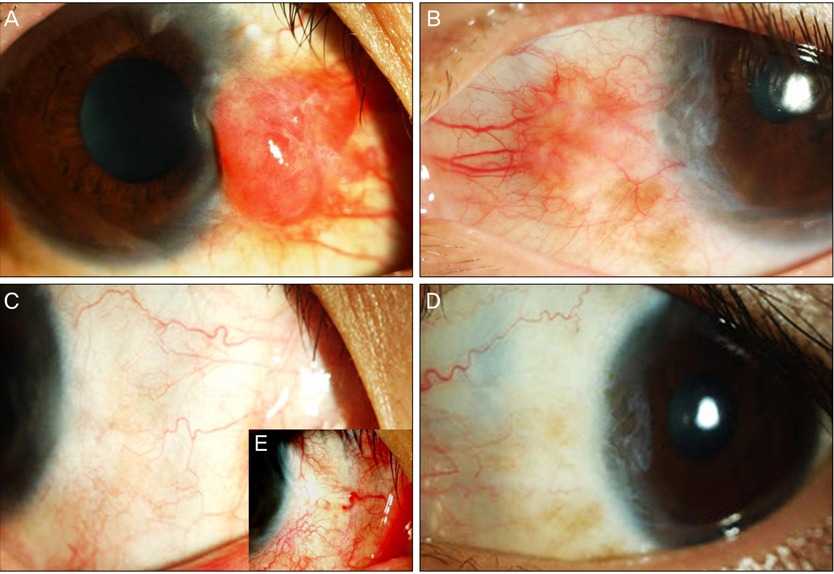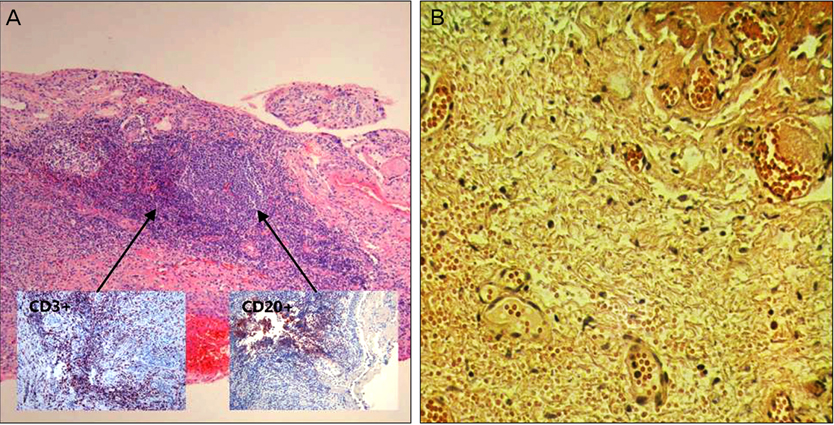Korean J Ophthalmol.
2011 Feb;25(1):57-59. 10.3341/kjo.2011.25.1.57.
A Case of Ocular Benign Lymphoid Hyperplasia Treated with Bevacizumab Injection
- Affiliations
-
- 1Department of Ophthalmology, Chung-Ang University College of Medicine, Seoul, Korea. JCK50ey@kornet.net
- KMID: 994414
- DOI: http://doi.org/10.3341/kjo.2011.25.1.57
Abstract
- We report the first case of ocular benign lymphoid hyperplasia (BLH) treated with subconjunctival injection of bevacizumab (Avastin). A 27-year-old man presented to our clinic with conjunctival masses and limbal neovascularization. An incisional biopsy yielded the diagnosis of BLH. The patient was subsequently given a subconjunctival injection of bevacizumab (1.25 mg / 0.1 mL). The patient did not experience recurrence or malignant metaplasia during the one-year follow-up period. In patients with conjunctival BLH, subconjunctival injection of bevacizumab can be a useful treatment option in patients unable to undergo a surgical procedure due to limbal neovascularization.
MeSH Terms
-
Adult
Angiogenesis Inhibitors/*administration & dosage
Antibodies, Monoclonal/*administration & dosage
Conjunctiva
Conjunctival Diseases/*drug therapy/*pathology
Humans
Hyperplasia
Injections, Intraocular
Limbus Corneae/blood supply
Lymphoid Tissue/*pathology
Lymphoproliferative Di
Male
Neovascularization, Pathologic/drug therapy
Figure
Reference
-
1. Jo YJ, Yim JH, Park KS. MALT (mucosa associated lymphoid tissue) type lymphoma of the ocular adnexa. J Korean Ophthalmol Soc. 2002. 43:357–362.2. Yu SB, Lew HL, Yun YS. A case of conjunctival benign lymphoid hyperplasia associated with ptosis of the eyelid in a child. J Korean Ophthalmol Soc. 2005. 46:560–564.3. Chang WS, Park JB, Kim KH, Kim SY. Two cases of conjunctival mucosa-associated lymphoid tissue (MALT) lymphomas treated by cryotherapy. J Korean Ophthalmol Soc. 2008. 49:1165–1172.4. Bolek TW, Moyses HM, Marcus RB Jr, et al. Radiotherapy in the management of orbital lymphoma. Int J Radiat Oncol Biol Phys. 1999. 44:31–36.5. Eichler MD, Fraunfelder FT. Cryotherapy for conjunctival lymphoid tumors. Am J Ophthalmol. 1994. 118:463–467.6. Ferrara N, Hillan KJ, Novotny W. Bevacizumab (Avastin), a humanized anti-VEGF monoclonal antibody for cancer therapy. Biochem Biophys Res Commun. 2005. 333:328–335.7. Lazic R, Gabric N. Intravitreally administered bevacizumab (Avastin) in minimally classic and occult choroidal neovascularization secondary to age-related macular degeneration. Graefes Arch Clin Exp Ophthalmol. 2007. 245:68–73.8. Jorge R, Costa RA, Calucci D, et al. Intravitreal bevacizumab (Avastin) for persistent new vessels in diabetic retinopathy (IBEPE study). Retina. 2006. 26:1006–1013.9. Manzano RP, Peyman GA, Khan P, et al. Inhibition of experimental corneal neovascularisation by bevacizumab (Avastin). Br J Ophthalmol. 2007. 91:804–807.10. DeStafeno JJ, Kim T. Topical bevacizumab therapy for corneal neovascularization. Arch Ophthalmol. 2007. 125:834–836.11. Hosseini H, Nejabat M. A potential therapeutic strategy for inhibition of corneal neovascularization with new anti-VEGF agents. Med Hypotheses. 2007. 68:799–801.12. Cursiefen C, Cao J, Chen L, et al. Inhibition of hemangiogenesis and lymphangiogenesis after normal-risk corneal transplantation by neutralizing VEGF promotes graft survival. Invest Ophthalmol Vis Sci. 2004. 45:2666–2673.13. Cursiefen C, Ikeda S, Nishina PM, et al. Spontaneous corneal hem- and lymphangiogenesis in mice with destrin-mutation depend on VEGFR3 signaling. Am J Pathol. 2005. 166:1367–1377.14. Björndahl MA, Cao R, Burton JB, et al. Vascular endothelial growth factor-a promotes peritumoral lymphangiogenesis and lymphatic metastasis. Cancer Res. 2005. 65:9261–9268.15. Hong YK, Lange-Asschenfeldt B, Velasco P, et al. VEGF-A promotes tissue repair-associated lymphatic vessel formation via VEGFR-2 and the alpha1beta1 and alpha2beta1 integrins. FASEB J. 2004. 18:1111–1113.16. Nagy JA, Vasile E, Feng D, et al. Vascular permeability factor/vascular endothelial growth factor induces lymphangiogenesis as well as angiogenesis. J Exp Med. 2002. 196:1497–1506.17. Bock F, Onderka J, Dietrich T, et al. Bevacizumab as a potent inhibitor of inflammatory corneal angiogenesis and lymphangiogenesis. Invest Ophthalmol Vis Sci. 2007. 48:2545–2552.
- Full Text Links
- Actions
-
Cited
- CITED
-
- Close
- Share
- Similar articles
-
- A Case of Conjunctival Benign Lymphoid Hyperplasia associated with Ptosis of the Eyelid in a Child
- A Case of Ocular Adnexal Benign Reactive Lymphoid Hyperplasia Recurred as Systemic Malignant Lymphoma
- Acute Visual Loss after Intravitreal Bevacizumab Injection in a Patient with Ocular Ischemic Syndrome
- Diagnostic Pediatric Colonoscopy for Lymphoid Hyperplasia of Terminal Ileum
- The Clinicopathologic Characteristics of Lymphoid Tumor of The Orbit and Ocular Adnexa



